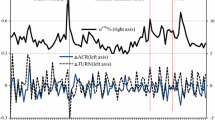Abstract
This paper examines the variance ratio tests in studies of transitory volatility and concludes that the variance ratio is an appropriate test of trading structure differences only under certain assumptions regarding the evolution of underlying stock prices and the autocorrelation structure of returns. This result raises caution as to the interpretation of results bases upon the 24-hour variance ratio methodologies in studies of transitory volatility and trading structure effects. A numerical example indicates that errors in inferences can be severe.
Similar content being viewed by others
References
Amihud, Y. and H. Mendelson, “Trading Mechanisms and Stock Returns: An Empirical Investigation.” Journal of Finance, (1987).
Amihud, Y. and H. Mendelson, “Market Microstructure and Price Discovery on the Tokyo Stock Exchange.” Japan and the World Economy 1, 341–370, (1989).
Amihud, Y. and H. Mendelson, “Volatility, Efficiency, and Trading: Evidence from the Japanese Stock Market.” Journal of Finance 46, 1765–1790, (1990).
Amihud, Y., H. Mendelson and M. Murgia, “Stock Market Microstructure and Return Volatility: Evidence from Italy.” Journal of Banking and Finance 14, 423–440, (1990).
Cao, C., H. Choe and F. Hatheway, What is Special about the Opening: Evidence from Nasdaq. Working paper, Pennsylaviania State University, 1994.
Choe, H. and H. Shin, An Analysis of Interday and Intraday Return Volatility: Evidence from the Korea Stock Exchange. Working paper, Pennsylaviania State University, 1993.
Dow, J. and G. Gorton, “Trading, Communication and the Response of Price to New Information.” The Economic Journal 103, 639–646, (1993).
Forster, M. M. and T. W. George, “Pricing Errors at the NYSE Open and Close: Evidence from Internationally Cross-Listed Stocks.” Journal of Financial Intermediation 5, 95–126, (1996).
French, K., “Trading Mechanisms and Value Discover: Cross National Evidence and Policy Implications, A Comment.” Carnegie-Rochester Conference Series on Public Policy 34, 131–134, (1991).
French, K. and R. Roll, “Stock Return Variances, the Arrival of Information and the Reaction of Traders.” Journal of Financial Economics 17, 5–26, (1986).
Gerety, M. and H. Mulherin, “Price Formation on Stock Exchanges: The Evolution of Trading within the Day.” Review of Financial Studies 7, 609–629, (1994).
George, T. and C. Hwang, “Transitory Price Changes and Price Limit Rules: Evidence from the Tokyo Stock Exchange.” Journal of Financial and Quantitative Analysis 30, 313–327, (1995).
George, T. and C. Hwang, “Information Flow and Pricing Errors: A Unified Approach to Estimation and Testing.” Review of Financial Studies 14, 979–1020, (2001).
George, T., C. Hwang and T. Ronen, Impriving Inference in Tests of Pricing Error Variances: An Application of the Bootstrap. Working paper, University of Iowa, 2001.
Glosten, L., “Components of the Bid-Ask Spread and the Statistical Properties of Transaction Prices.” Journal of Finance 42, 1293–1307, (1987).
Glosten, L. and P. Milgrom, “Bid, Ask and Transaction Prices in a Specialist Market with Heterogeneously Informed Traders.” Journal of Financial Economics 14, 71–100, (1985).
Hasbrouck, J., “The Summary Informativeness of Stock Trades: An Econometric Analysis.” Review of Financial Studies 4, 571–595, (1991).
Hasbrouck, J., “Assessing the Quality of a Security Market: A New Approach to Transaction-Cost Measurement.” Review of Financial Studies 6, 191–212, (1993).
Hasbrouck, J. and R. Schwartz, “Liquidity and Execution Costs in Equity Markets (with Robert Schwartz).” Journal of Portfolio Management, (1998).
Jones, C., G. Kaul and M. Lipson, “Information, Trading, and Volatility.” Journal of Financial Economics 36, 127–154, (1994).
Leach, C. and A. Madhavan, “Price Experimentation and Security Market Structure.” Review of Financial Studies 6, 375–404, (1993).
Masulis, R. and V. Ng, Stock Return Dynamics over Inter-Day Trading and Non-Trading Periods in the London Stock Market. Working paper, Vanderbilt University, 1991.
Mech, T. S., “Portfolio Return Autocorrelation.” Journal of Financial Economics 34, 307–344, (1993).
Merton, R., “OnEstimating the Expected Return on the Market:AnExploratory Investigation.” Journal ofFinancial Economics 8, 323–361, (1980).
Ozenbas, D., R. Schwartz and R. Wood, “Volatility in U.S. and European Equity Markets: An Assessment of Market Quality.” International Finance, (2002), forthcoming.
Roll, R., “A Simple Model of the Implicit Bid-Ask Spread in and Efficient Market.” Journal of Finance 39, 1127–1139, (1984).
Romer, D., “Rational Asset Price Movements without News.” American Economic Review 83, 112–1130, (1993).
Ronen, T., “Tests and Properties of Variance Ratios in Microstructure Studies.” Journal of Financial and Quantitative Analysis 32, 183–204, (1997).
Ronen, T., “Trading Structure and Overnight Information: A Natural Experiment from the Tel-Aviv Stock Exchange.” Journal of Banking and Finance 22, 489–512, (1998).
Stoll, H. and R. Whaley, “Stock Market Structure and Volatility.” Review of Financial Studies 3, 37–71, (1990).
Author information
Authors and Affiliations
Rights and permissions
About this article
Cite this article
Ronen, T. Observable Consequences of Trading Structure Differences: On the Use of Variance Ratios in Microstructure Studies. Review of Quantitative Finance and Accounting 20, 187–200 (2003). https://doi.org/10.1023/A:1023050226457
Issue Date:
DOI: https://doi.org/10.1023/A:1023050226457




